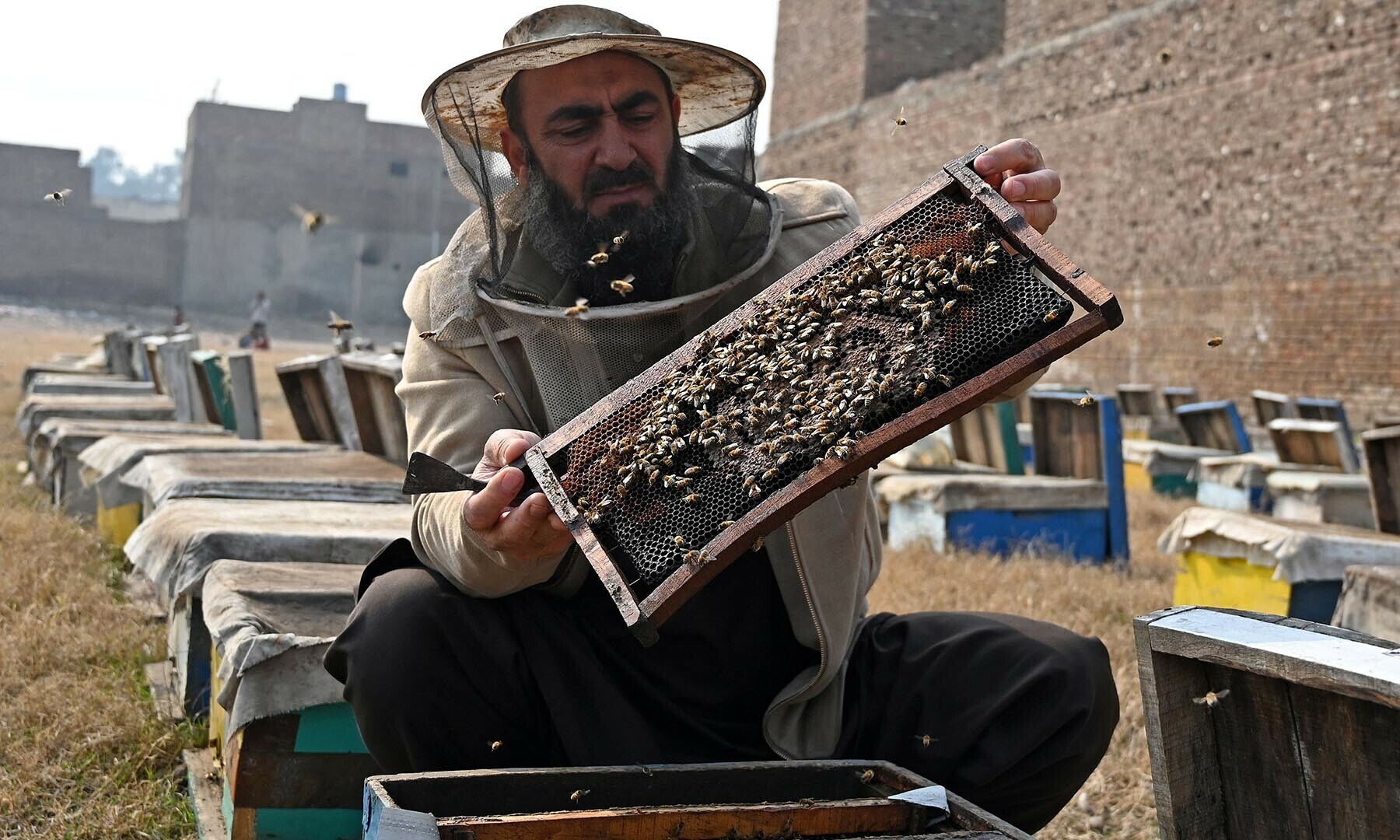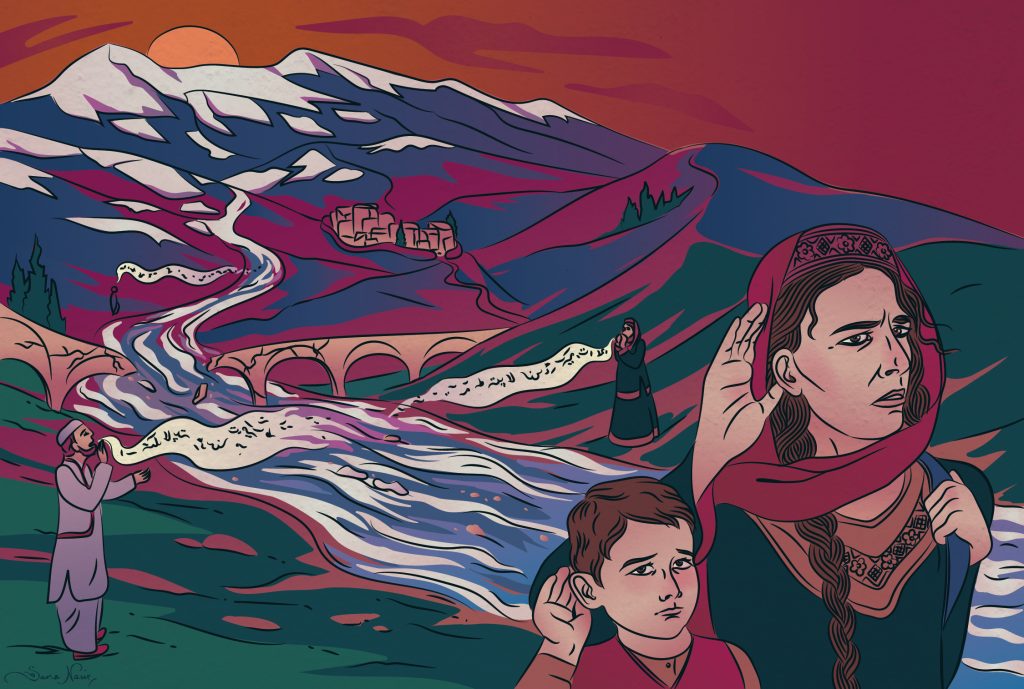| Recent heavy rains and hailstorms caused severe damage to crops and property across Khyber Pakhtunkhwa |
BY ASAD ZIA
Anwar Ullah, a farmer from Katlang tehsil in Mardan district, inspects his tomato fields that were severely damaged during last week’s heavy rain and hailstorm. He says the unexpected weather events destroyed his orchards and crops of wheat, fruits and vegetables.
“Our crops were ready for harvest; our orchards were full of fruit ready to be picked. But the sudden rain and hail caused massive losses. Every farmer here has suffered losses worth millions” he says disappointedly.
“In forty years, I have never seen a hailstorm like the one we had last week,” he says. The hailstorm also damaged his solar panels.
“People are now worried. How will they protect their crops, orchards, and homes if these storms become a regular occurrence?”
According to Muhammad Waseem Tariq, duty forecast officer at the Regional Meteorological Centre in Peshawar, heavy rain and hail were forecast to continue until April 20. After that, dry weather was expected in areas like Peshawar, Mardan, Charsadda and southern Khyber Pakhtunkhwa.
He says that rain might still occur in the hilly areas of northern Khyber Pakhtunkhwa such as Mansehra, Abbottabad and Shangla in the coming days. Temperatures in the plains are expected to rise. He advises farmers and outdoor workers to protect themselves from heatwaves by covering their heads and staying hydrated.
A report by the Khyber Pakhtunkhwa Provincial Disaster Management Authority stated that heavy rain and thunder on April 18 and April 19 resulted in two deaths; eleven others were injured in various parts of the province. Around 50 cattle perished and 21 houses and schools were destroyed.
Rain and thunderstorms affected several districts, including Battagram, Buner, Karam, Karak, Bajaur, Mohmand, Peshawar, Charsadda, Mardan, Swabi, Khyber, Orakzai, Kohat, Bannu, Waziristan, Tank, Lakki Marwat and Dera Ismail Khan. Northern regions such as Chitral, Dir, Swat, Shangla, Kohistan, Malakand, Mansehra and Abbottabad also experienced intense hailstorms.
The PDMA warned that rising temperatures could trigger glacial lake outburst floods in areas such as Lower and Upper Chitral, Upper Dir, Swat and Kohistan. Melting snow and glaciers pose a serious risk of flooding in these mountain valleys.
Environmental expert Dr Muhammad Rasheed warns that the monsoon season in the Peshawar region might shift from the July-August period to March-April or March-May as a result of climate change. He says this shift would be disastrous for crops ready for harvest. He advises farmers to delay planting of tobacco and vegetables to avoid losses.
Muhammad Waseem Tariq says that hailstones form due to sharp temperature differences in the atmosphere. He notes that extreme weather events are becoming more frequent, adding that the large size of recent hailstones is evidence of those changes.
Ashfaq Khan, a tobacco farmer in Mardan, says their crop was heavily damaged due to hailstorms that hit the area thrice since planting began in February. “Every rainfall came with hail. Our tobacco leaves are torn,” he says.
Taimur Hassan, a resident of Peshawar, says that hailstones the size of golf balls damaged many homes and solar panels. He urged the PDMA and weather authorities to issue early warnings through both social and mainstream media to help people prepare in advance.
Climate expert Muhammad Asif Khan says that climate change is not only an environmental threat but also a danger to Pakistan’s economic stability. Without effective action, he says climate-induced disasters would become more intense and frequent.
He notes that Pakistan has already experienced a significant temperature rise—about 0.5 degree Celsius since the 1960s—and projected that the average temperature could increase by 1.3 degree Celsius to 1.5 degree Celsius by 2050.
Rainfall patterns are also becoming increasingly unpredictable. Some regions face reduced precipitation while others experience more intense, irregular rainfall, contributing to both droughts and floods.
The World Bank has estimated that the combined risks from extreme climate events, environmental degradation and air pollution could reduce Pakistan’s GDP by 18 to 20 percent by 2050, hindering progress on economic development and poverty reduction.
According to the Khyber Pakhtunkhwa Climate Change Policy 2022, the province is geographically diverse. It encompasses the Hindu Kush, Himalayan and Karakoram Mountain ranges in the north, northwest and east, and plains in the south that are agricultural and rangeland zones.
The northern parts of Khyber Pakhtunkhwa experience extremely cold, snowy winters and pleasant summers with significant rainfall. In contrast, the southern regions have milder winters, hotter summers and moderate rainfall. Chitral, the highest district in the province, records the lowest winter temperatures and is home to many glaciers. Meanwhile, Dera Ismail Khan in the south experiences a climate suitable for year-round agriculture.
Khan says that while rest of the world is proactively creating climate change strategies and raising public awareness, our policymakers appear to lack interest, even in educating themselves on the issue.
He says that the recent hailstorm and heavy rains highlight just how unprepared the country is to brace the impacts of climate change. “In Islamabad, people didn’t even have time to move their vehicles to safer locations. The losses to solar panels and cars ran into millions of rupees.”
Both the federal and provincial governments must take this issue seriously and establish mechanisms to educate the public about climate change, he says. “If these conditions persist, Pakistan could soon become one of the most affected countries in the world.”
The writer is a freelance journalist based in Peshawar



